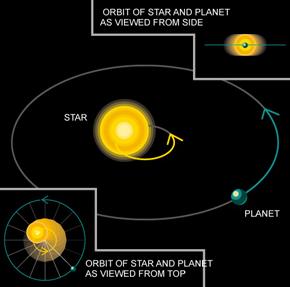How Extra-solar Planets are Discovered
Even for very nearby stars, planets are simply too dark and small to be imaged directly. We must infer their presence based on their gravitational-influence on the stars around which they orbit. What does the diagram below remind you of? A teeter-totter between a very big person and a small person.

 As a massive planet orbits around a star, each pulls gravitationally on the other.
The star and planet move around their center of mass. For the Sun-Jupiter
system, this is a point just outside the Sun's surface. The Star and planet are
always on the opposite sides of this center of mass point. (Click Here for an animation).
As a massive planet orbits around a star, each pulls gravitationally on the other.
The star and planet move around their center of mass. For the Sun-Jupiter
system, this is a point just outside the Sun's surface. The Star and planet are
always on the opposite sides of this center of mass point. (Click Here for an animation).
While we are familiar with the thought of a `planet orbiting the Sun', we must realize that in fact, the star also moves. If its a BIG planet, then it causes the star to make a much larger circle for each orbital period. Astronomers look for stars moving in such large circles.
How do we detect wobbling Stars?
1) Astrometric technique You see the star moving back and forth
on the sky. This is impossible to do from the ground because stars are blurred
by the atmosphere.
2) Doppler Shift or Doppler technique. This technique is by far
the most common method used. Here, we study the light coming from the Star
very carefully, and look for changes in the wavelength of the light, first
to red, then to blue and back to red, in a continuous cycle. These changes
represent motion of the star towards and away from us, as it orbits the planet-star
center of mass.